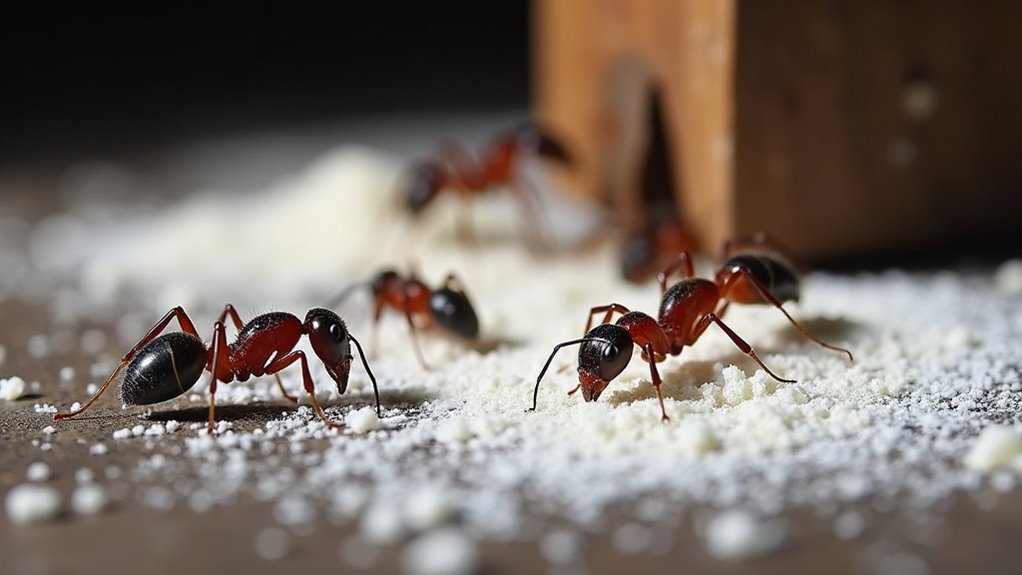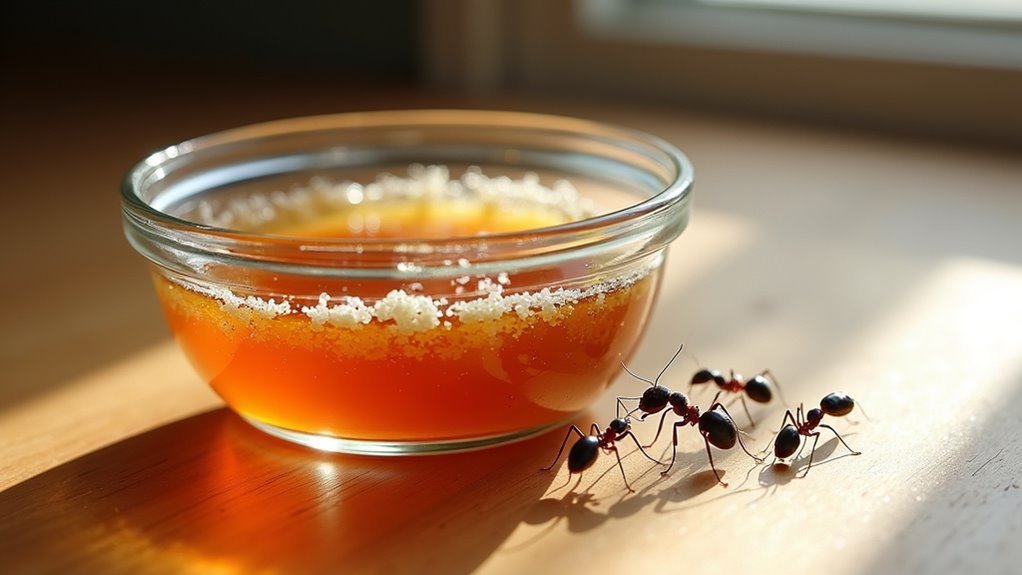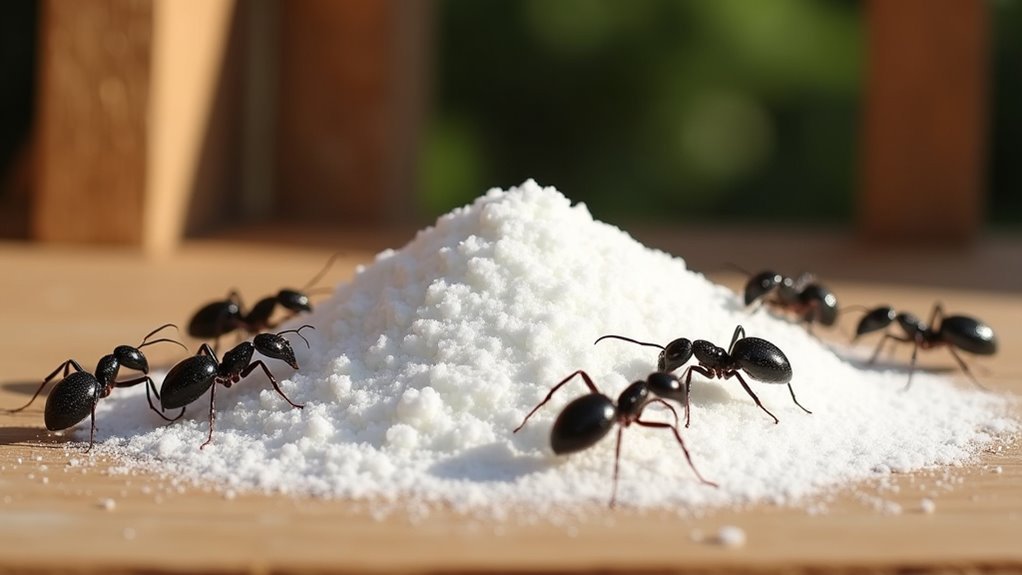You can eliminate carpenter ant colonies by creating boric acid bait that exploits their food-sharing behavior. Mix three parts sugar with one part boric acid, add water to form a thick paste, and place it near ant trails in small containers. The slow-acting poison spreads throughout the colony as worker ants carry it back to feed others, reaching the queen within 7-10 days for complete elimination. This thorough approach reveals additional strategies for maximum effectiveness.
Understanding Carpenter Ant Behavior and Identification

Before you can effectively eliminate carpenter ants from your property, you’ll need to understand their behavior and properly identify them. These ants range from 1/4 to 1/2 inch in size and display red or black coloration, setting them apart from other species.
Unlike termites, they don’t consume wood but excavate it to build their nests, preferring moist or decaying timber.
You’ll recognize infestations through visible ant trails, scattered wood shavings, and hollow-sounding wood when tapped. Finding the carpenter ant nest proves essential for elimination success, though these colonies often hide inside walls or concealed areas.
How Boric Acid Works Against Carpenter Ant Colonies
When you use boric acid against carpenter ants, you’re leveraging their natural food-sharing behavior to distribute poison throughout the entire colony.
Worker ants consume the boric acid bait and carry it back to feed other colony members, including the queen and larvae.
This slow-acting poison won’t kill ants immediately, giving them time to spread the lethal substance before the elimination process begins.
Colony-Wide Poison Distribution
Since boric acid operates as a slow-acting poison, it creates a devastating chain reaction throughout carpenter ant colonies. When you use Boric Acid for Carpenter ant elimination, worker ants consume the bait and return to share it with their nestmates through food sharing behaviors. This distribution method guarantees maximum colony penetration.
The poison spreads effectively because:
- Worker ants regurgitate food to feed larvae, pupae, and the queen
- Multiple ants consume the bait before experiencing symptoms, preventing colony alarm
- Shared feeding behaviors naturally distribute the poison to all colony members
Within 7 to 10 days, you’ll see the poison’s effects reach every level of the colony hierarchy. The slow-acting formula disrupts digestive systems gradually, allowing complete distribution before mortality occurs, ultimately causing total colony collapse.
Slow-Acting Elimination Process
Unlike fast-acting contact poisons that kill carpenter ants immediately upon exposure, boric acid requires ingestion to begin its lethal work within the ant’s body.
Once consumed, it disrupts the ant’s digestive system and metabolism, causing death within 24 to 48 hours.
This delayed action creates a significant advantage. Worker ants can return to their colony and share the boric acid bait with other members through food sharing behaviors.
The queen and developing brood also receive the poison, ensuring thorough colony treatment.
You’ll need patience with this method. Complete colony elimination takes 7 to 10 days as the poison circulates throughout the entire population.
This timeline allows all ants to consume lethal doses before the initial deaths occur, maximizing the treatment’s effectiveness against the entire carpenter ant colony.
Creating Liquid Boric Acid Bait for Maximum Effectiveness

You’ll achieve the best results by mixing three parts sugar with one part boric acid, creating a smooth blend that attracts carpenter ants effectively.
Add water gradually to form a thick paste, then enhance the mixture’s stickiness with 1/4 cup of syrup for better adherence to ant trails.
Place this bait in small containers like jar lids near known ant trails and nests, replacing it every few days to maintain its killing power.
Proper Mixing Ratios
When creating liquid boric acid bait, you’ll need to achieve the perfect balance between attraction and lethality by mixing 3 parts sugar with 1 part boric acid. This ratio guarantees carpenter ants are drawn to the sweetness while consuming enough poison to eliminate the colony.
For precise measurements, follow these mixing guidelines:
- Combine 1/3 cup boric acid with 1 cup sugar, blending thoroughly until no lumps remain.
- Gradually add water to create a thick paste consistency.
- Mix in 1/4 cup syrup for enhanced stickiness and attraction.
The sugar acts as bait while the boric acid delivers the lethal dose.
Don’t increase the acid concentration beyond this ratio, as it’ll make the mixture too bitter and deter ants from feeding.
Strategic Placement Techniques
After you’ve mixed your liquid boric acid bait to the proper consistency, placement becomes the critical factor that determines whether you’ll eliminate the entire colony or simply waste your efforts.
These strategic placement techniques will maximize your carpenter ant control success. Place small amounts in jar lids or bottle caps near observed ant activity and along established trails.
Position baits close to the suspected colony location so worker ants can easily transport the poison back to their nest. This guarantees the entire colony, including the queen, gets exposed to the boric acid.
Replace baits every few days to maintain potency, as fresh bait remains essential for effective elimination.
Making Solid Boric Acid Bait Formulations
While liquid baits work well for many ant species, solid boric acid formulations prove more effective against carpenter ants due to their feeding preferences.
You’ll need to create the right mixture to guarantee maximum attraction and colony elimination.
To make your solid boric acid bait:
- Mix 1 part boric acid with 3 parts powdered sugar for ideal carpenter ant attraction
- Blend ingredients thoroughly to eliminate lumps that might deter ants from consuming the bait
- Replace the bait every few days to maintain its effectiveness and appeal
Place your powdered bait along known ant trails and entry points.
As worker ants encounter the mixture, it’ll cling to their exoskeletons during grooming, facilitating ingestion and spreading the poison throughout their nest.
Proper Application Techniques and Placement Strategies

Creating effective bait represents only half the battle—strategic placement determines whether your carpenter ant elimination efforts succeed or fail.
Place your boric acid mixture in small containers like jar lids or bottle caps near ant trails and suspected nesting areas. You’ll maximize effectiveness by positioning baits where you’ve observed frequent ant activity, ensuring foraging workers can easily access them.
Keep placements away from moisture, which reduces the bait’s potency. Check your stations every few days, revitalizing dried or degraded bait to maintain attractiveness.
For thorough control, dust boric acid into hard-to-reach voids where ants establish nests. Monitor treated areas closely—you should notice decreased activity within several days if placement is successful.
Targeting Carpenter Ant Nests and Hidden Areas
Success depends on finding and targeting the main colony, not just the workers you see marching across your counters. Following ant trails reveals where carpenter ants travel, leading you directly to their hidden headquarters where the queen and brood reside.
Focus your inspection on these common nesting locations:
- Hollow doors and wall voids – Check for small holes or sawdust piles indicating excavation
- Under insulation – Look in attics, basements, and crawl spaces where moisture collects
- Window frames and sill plates – Examine areas where wood meets moisture sources
Once you’ve located their nest, place boric acid bait strategically along the trails leading to these areas.
Don’t spray insecticides directly on the trails – this alerts the colony and causes relocation, making your job harder.
Safety Precautions When Using Boric Acid Around Homes
Before you begin placing boric acid baits throughout your home, protecting your family and pets from accidental exposure must be your top priority.
Keep boric acid away from children and pets since ingestion causes toxicity and serious health problems. Always wear gloves and a mask when handling this substance to prevent skin irritation and respiratory issues during mixing and application.
Store boric acid in a secure, clearly labeled container that’s completely out of reach.
Apply your baits in areas inaccessible to pets and children, such as inside wall voids or behind appliances. This placement strategy reduces accidental contact risks while maintaining effectiveness against carpenter ants.
Follow manufacturer instructions precisely for application amounts and safety measures to guarantee both safe and successful pest elimination results.
Timing and Frequency of Boric Acid Treatments
When you’re ready to deploy boric acid treatments, timing becomes essential for eliminating the entire carpenter ant colony. You’ll need patience, as it typically takes 7 to 10 days to see noticeable results. This timeframe allows the poison to reach the queen and entire colony.
Patience is key when using boric acid against carpenter ants – expect 7-10 days for the poison to eliminate the entire colony.
For maximum effectiveness, follow these application guidelines:
- Apply fresh bait every few days to maintain attraction and potency
- Monitor bait stations regularly – quick consumption indicates larger infestations requiring more frequent treatments
- Reapply after heavy rainfall or cleaning, as water dilutes the boric acid’s effectiveness
Place your boric acid bait where you’ve observed ant activity and replenish it consistently. This continuous supply guarantees foraging ants keep returning to the poison, ultimately destroying the entire carpenter ant colony.
Signs That Your Boric Acid Treatment Is Working
Three key indicators will tell you whether your boric acid treatment is effectively targeting the carpenter ant colony. You’ll notice decreased ant sightings within 3-10 days as the boric acid affects the nest. Dead ants near bait stations confirm workers are consuming and transporting the poison back to their colony.
| Timeline | What You’ll Observe |
|---|---|
| Days 1-3 | Increased activity as ants discover bait |
| Days 3-7 | Dead ants appearing near stations |
| Days 7-10 | Noticeable decrease in sightings |
| Week 2+ | Elimination of ant trails |
| Ongoing | Empty bait stations with little activity |
Initially, you might see more ant activity as they’re drawn to your bait. However, this should quickly subside. When the queen and brood are affected, you’ll see significant population reduction and eventually no visible trails.
Why Carpenter Ants May Avoid Boric Acid Baits
Despite following proper bait placement techniques, you might find that carpenter ants completely ignore your boric acid stations. Several factors explain this frustrating behavior that can undermine your pest control efforts.
Carpenter ants often avoid boric acid baits because they’re naturally selective feeders. They’ll bypass treated baits when more appealing food sources are available nearby. The ants may also detect the boric acid itself and associate it with danger, triggering avoidance behaviors.
Carpenter ants are picky eaters who will choose natural food sources over boric acid baits when given better options.
Common reasons for bait rejection include:
- Poor bait formulation – The attractant isn’t appealing to carpenter ants’ specific dietary preferences
- Environmental competition – Other food sources are more accessible or attractive
- Detection sensitivity – Ants recognize the boric acid’s presence and avoid the contaminated bait
Understanding these limitations helps you adjust your strategy accordingly.
Combining Boric Acid With Other Natural Control Methods
You’ll boost your boric acid treatment’s effectiveness by incorporating essential oil deterrents that disrupt ant navigation patterns.
Diatomaceous earth works as a powerful complement when applied around entry points and along ant trails, creating barriers that enhance your boric acid baits.
These natural methods work together to attack carpenter ants from multiple angles while they’re carrying poison back to their colonies.
Essential Oil Deterrents
Why settle for boric acid alone when you can amplify its effectiveness with essential oils? This powerful combination creates a dual-action approach that disrupts ant navigation while delivering lethal poison to worker ants.
Essential oils like peppermint, tea tree, cinnamon, and clove mask the pheromone trails carpenter ants depend on for navigation. This makes it harder for them to locate food sources and return to their nests.
When you add a few drops of essential oil to your boric acid bait, you’ll enhance its attractiveness while providing additional repellent action.
- Mix essential oils directly with boric acid to create enhanced baits
- Apply oils around ant trails to disrupt their navigation system
- Refresh applications regularly as scents diminish over time
Diatomaceous Earth Application
Adding diatomaceous earth to your boric acid arsenal creates a one-two punch that attacks carpenter ants from multiple angles. While boric acid works as an ingested poison, DE physically damages their exoskeletons, causing dehydration and death upon contact.
| Application Method | Boric Acid Function | DE Function |
|---|---|---|
| Dust mixture in ant trails | Ingested poison | Physical damage to exoskeleton |
| Apply around entry points | Attracts ants as bait | Creates protective barrier |
| Target moisture-prone areas | Maintains toxicity when dry | Loses effectiveness when wet |
| Regular reapplication needed | Refresh bait stations | Reapply after rain/cleaning |
| Combined effectiveness | Targets feeding behavior | Targets movement patterns |
Dust this combination where you’ve spotted carpenter ant activity, keeping it dry for maximum impact. You’ll need to reapply regularly, especially after moisture exposure.
Limitations of DIY Boric Acid Solutions
While boric acid can be an effective tool against carpenter ants, DIY solutions come with several significant limitations that may compromise your pest control efforts.
Understanding these constraints helps you make informed decisions about tackling your carpenter ant infestation.
The limitations of DIY boric acid solutions include:
- Inadequate formulation strength – Over-the-counter products often lack the proper concentration needed for complete colony eradication.
- Complex application requirements – You’ll need precise mixing ratios and placement techniques to create attractive, effective baits.
- Safety concerns – Keeping the solution away from pets and children requires constant vigilance due to potential health risks.
For larger infestations, you’ll likely need additional control measures since boric acid alone won’t completely eliminate established colonies.
Some ant species may even show aversion to these treatments.
When to Consider Professional Pest Control Services
Given these challenges with DIY approaches, certain situations call for bringing in professional pest control services.
If your boric acid treatments haven’t eliminated carpenter ants within a few weeks, it’s time to seek expert help. You should also contact professionals immediately if you notice visible structural damage to your home, as this indicates a severe infestation requiring urgent attention.
Professional exterminators possess advanced treatments and techniques to target hidden nests you can’t reach.
Professional pest control experts have specialized equipment and methods to locate and eliminate carpenter ant colonies in inaccessible areas of your home.
They’ll provide thorough assessments and tailored treatment plans if you’re dealing with multiple colonies or increasing ant activity. Additionally, pest control professionals guarantee safe chemical application, which is especially important if you have children or pets at home.
Preventing Future Carpenter Ant Infestations
Once you’ve successfully eliminated carpenter ants from your home, taking proactive steps will prevent future carpenter ant infestations and save you from costly damage down the road.
Control begins with understanding what attracts these destructive pests and eliminating those conditions.
Your prevention strategy should include:
- Seal entry points – Inspect and seal cracks, gaps around pipes, and windows where carpenter ants might enter
- Eliminate moisture – Guarantee proper drainage and ventilation in basements and attics since these pests prefer damp wood for nesting
- Remove attractants – Keep wood piles and mulch away from your foundation while storing food in airtight containers
Conduct routine monitoring for wood damage or ant trails to catch problems early and maintain your pest-free environment.
Frequently Asked Questions
How Long Does Boric Acid Take to Kill Carpenter Ants?
You’ll see carpenter ants die within 24 to 48 hours after they’ve ingested boric acid, but you’ll need to wait 7 to 10 days for complete colony elimination.
What Is the Fastest Way to Get Rid of Carpenter Ants?
You’ll get fastest results by hiring a professional exterminator who can locate and eliminate nests within three days. Alternatively, use boric acid-sugar bait near ant trails for elimination within 24-48 hours.
Will Sprinkling Boric Acid Kill Ants?
Sprinkling boric acid won’t effectively kill ants since they’ll likely avoid it. You’ll get better results mixing it with sugar to create bait they’ll eat and carry back to their colony.
Is Borax or Boric Acid Better for Carpenter Ants?
You’ll find boric acid works better than borax for carpenter ants. It’s safer around pets, acts as a slow poison allowing colony transfer, and attracts more ants when mixed with sweet baits.
In Summary
You’ll find boric acid effective against carpenter ants when you’re patient and consistent with your approach. Don’t expect instant results—it takes time for the poison to circulate through the colony. If you’re dealing with extensive damage or large infestations, you’ll want to call professionals. Remember, prevention’s your best defense, so keep moisture levels low and seal entry points to avoid future problems.





Leave a Reply